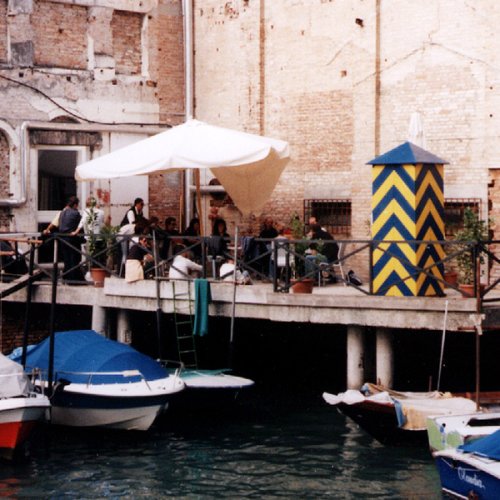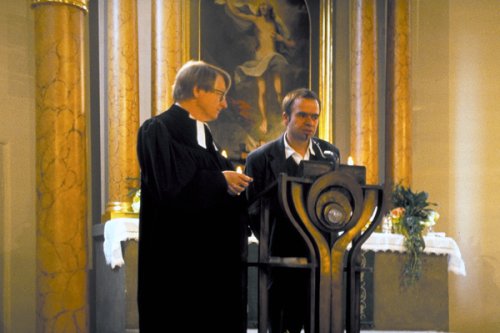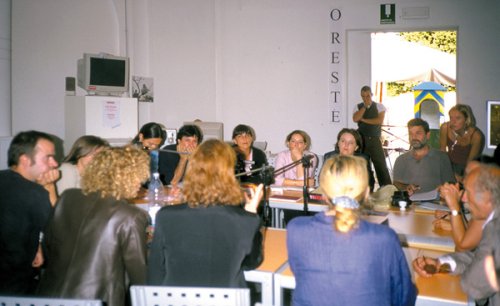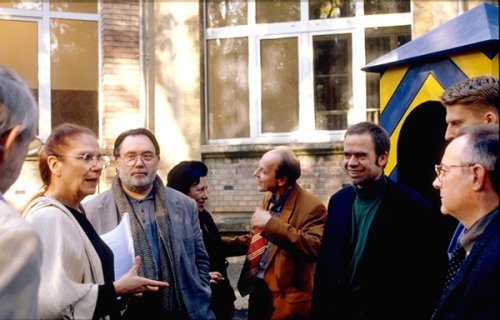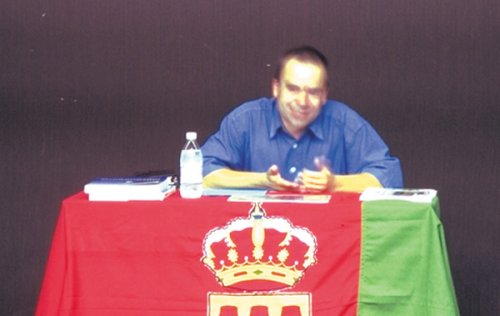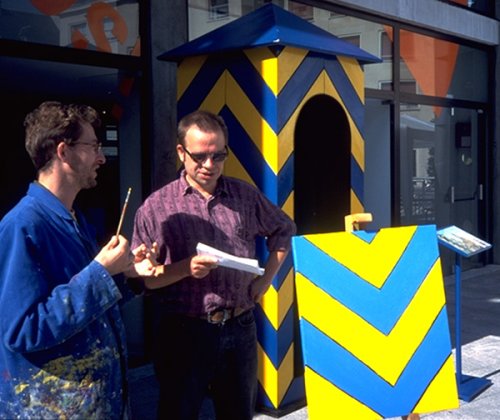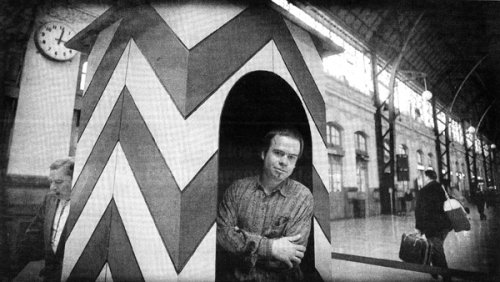- zur Person
- |
- Kontakt
- |
- CV
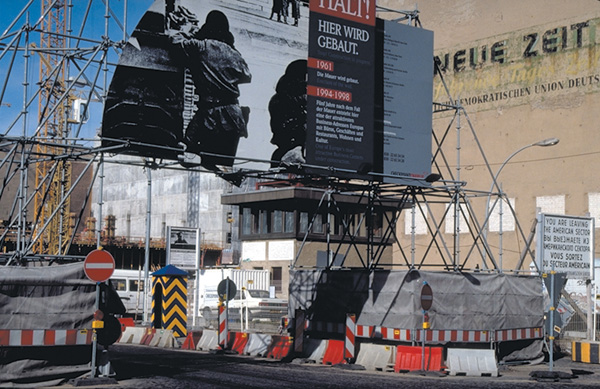
The Border Liner Project
1992
A travelling frontier
A border-guard’s lodge, painted in the colours of the European Union, blue and yellow, symbolizes the European frontier. This lodge is travelling through the EU.
The guard himself has been dismissed and instead been replaced by a commemorative plaque, which can be seen inside. Made of gold-plated marble, it displays an inscription, carved in the 12 current EC-languages:
„More crossing the frontiers“
A permanent companion to the „cross-border commuter’s lodge“ is the artist Stephan Kurr. He makes speeches and gives talks, he does PR-work using flyers, information desks, writes letters to politicians, and searches for promoters. Working as a sort of NGO, he executes his project.
Final station of his voyage is to be the platform of the missing southern tower of the Strasbourg Cathedral. There he wants to built up the „cross-border commuter’s lodge“ for the last time.
With the presence of the plaque, Stephan Kurr subverts the meaning the guard’s lodge, a symbol of demarcation, and presents an appeal for open frontiers. More than referring only to borders between countries, it appeals to the people themselves, to overcome their own inhibitions.
By placing the guard’s lodge on top of the Strasbourg Cathedral it reflects and places emphasis on the idea of the extension of the „Edifice Europe“, which shouldn’t be merely a political or economical aim, but rather an essential human quality: the courage to approach the unknown and the strange.
The idea to the project was published in 1992 in „Megalomania - Art-Projects For Europe“, by Lindinger & Schmidt, Regensburg. It came into real with the building of the border-guard’s lodge in 1994.
1997-1998 the border-guard’s lodge went on tour:
Checkpoint Charlie, Berlin (D) installation next to the then still existing watchtower of the former GDR border fortification. Inauguration by Frieder Otto Wolf (EU-Parliament).
Gallery La Station, Nice (F) „10 jours d’art contemporain“, Talk with Ben Vautier.
Hôtel des Régions, Limoges (F) Meeting of municipalities of the EU, Speech to local politicians at the Parliament of the Limousin;
„ Escenas para un laberinto”. V Festival Internacional de Teatro de Calle de Alcorcón, Madrid (E) interventions in the public space and street theatre festival; organized by El Perro
„AGORA“, Maison de la Culture d’Amiens (F) Performance with colleagues from Amiens
„Les Centres des Marges. Vers un itinéraire culturel européen “, CRAC Alsace, Altkirch (F) congress and exhibition.
CRÉDAC d’Ivry, Paris (F) intervention in the public space
Estación del Norte, Valencia (E) exhibition in the railwaystation
Estación del Ferrocarril, Alicante (E) exhibition in the railwaystation
Ecumenical church congress, Fürth (D) sermon by superintendent Dr. Ludwig Markert;
„Når det fremmede foruroliger“, Sønderjylands Kunstmuseum, Tønder (DK) conference of historians
„Situazioni/Situationisti - Zebra Crossing“, Unione Culturale Franco Antonicelli, Turin (I) groupexhibition, curated by a.titulo
„Arte pubblica. Progetti ed esperienze europee“ Spazio Oreste, 48th Venice Biennale (I) curated by a.titulo
The project has been supported and promoted by
Wolfgang Kreissl-Dörfler (Munich) and Frieder Otto Wolf (Berlin) both members of the European Parliament, Bündnis’90 / die Grünen, Conselleria de Cultura de Valencia, RENFE, Transworld Communication, Office for International Relationships of the City of Nürnberg and the Ministry of Cultural Affairs of Bavaria.
Jack Lang former minister of culture of France was gained as patron of the project.
Publications including the project:
„Megalomania - Art-Projects For Europe“, Lindinger & Schmidt, Regensburg, 1992 (ISBN 3-929970-03-1)
Public Art, European Experiences and Projects, (English and Italian) by Alessandra Pioselli, pg. 201ff, in „Oreste alla Biennale“, edited by Giancarlo Norese, Edizioni Charta, Milan, 2000 ( ISBN 88-8158-279-1)
Arte e pubblicità, by Elio Grazioli, edizioni Bruno Mondadori, Milan, 2001 (ISBN 88-424-9706-1)
After the elections of 1998 in France and in Strasbourg, there was no more political will by the responsibles to realize the project at Strasbourg’s cathedral. After cutting of funds by the Bavarian Ministry of Science and Culture, it caused huge financial trouble of the artist, what made him decide to finish the project.
The border-guard’s lodge was exhibited for the last time in 1999 by invite of “a.titulo” at Spacio Oreste in the Italian Pavillon at the 48th Biennale di Venezia

